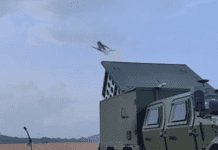This post is also available in:
 עברית (Hebrew)
עברית (Hebrew)
The MQ-72C Logistics Connector, a rotary-wing unmanned aerial system (UAS) derived from the UH-72 Lakota platform, is set to begin trials with integrated autonomous flight capabilities. As part of an extended initiative to modernize airborne logistics operations, Airbus has partnered with defense AI developer Shield AI to explore the drone’s ability to operate with minimal human intervention in complex mission environments.
At the center of this effort is the integration of Hivemind, Shield AI’s artificial intelligence pilot system, with Airbus’ Helionix avionics suite. The goal: enabling the MQ-72C to perform logistics missions autonomously, including in contested or austere environments where traditional crewed aircraft may be limited.
The MQ-72C builds on the legacy of the UH-72 Lakota, a light utility helicopter widely used by the U.S. Army and National Guard. Its proven airframe now serves as a testbed for advanced autonomy, offering a reliable platform for both military experimentation and eventual deployment, according to the press release.
This work supports broader autonomy initiatives within the U.S. Department of Defense, including the U.S. Marine Corps’ interest in unmanned aerial logistics for expeditionary operations. Initial MQ-72C flight evaluations were completed in late 2024 as part of a naval program aimed at identifying next-generation air logistics solutions, according to The Defense Post.
Hivemind is already being deployed in other platforms, including the V-BAT drone, which has been adopted by the U.S. Coast Guard. Its core capability lies in replicating the skills of experienced pilots through onboard AI, enabling systems to fly, navigate, and adapt in dynamic environments without GPS or communications support.
If successful, the MQ-72C program could mark a significant step toward fully autonomous rotary-wing drones designed for scalable, resilient logistics missions—redefining aerial supply chains in future combat zones.


























